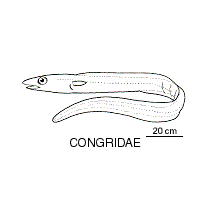- Classification
- ACTINOPTERYGII
- ANGUILLIFORMES
- CONGRIDAE
-
Fish Classification
-
Class
ACTINOPTERYGII Ray-finned fishes -
Order
ANGUILLIFORMES Eels -
Family
CONGRIDAE Conger eels -
Genera
Acromycter(0) Ariosoma(6) Bassanago(2) Bathycongrus(4) Bathyuroconger(2) Blachea(1) Castleichthys(1) Conger(3) Congriscus(1) Diploconger(1) Gavialiceps(1) Gnathophis(8) Gorgasia(3) Heteroconger(1) Lumiconger(1) Macrocephenchelys(2) Parabathymyrus(1) Promyllantor(1) Rhynchoconger(1) Scalanago(1) Uroconger(1)
Family CONGRIDAE
Marine eels with the dorsal-fin origin about level with or not far behind the gill openings, pectoral fins present, a prominent lateral line, and rather modest dentition that is typically in the form of bands of small teeth on the jaws and the roof of the mouth. Conger eels lack scales and grow to a length of more than 2.5 metres and weight of more than 60 kg.
The garden eels (subfamily Heterocongrinae) differ from most other members of the family in having the body greatly elongate and the pectoral and caudal fins reduced or absent. Conger eels are seldom brightly coloured.
More Info
|
Family Taxonomy |
The family includes more than 180 species in more than 30
genera and is divided into three subfamilies: Congrinae - tail usually greater than 60% of total length, pectoral fins well-developed, dorsal and anal- fin rays segmented. Bathymyrinae - tail usually less than 60% of total length, pectoral fins well-developed, dorsal and anal-fin rays unsegmented. Heterocongrinae - the garden eels, with very long slender bodies and pectoral fins very tiny or absent. |
|
Family Distribution |
Congrids are found worldwide in tropical to temperate regions, living in shallow to deep waters. |
|
Family Description |
Medium to large-sized marine eels with a long to very long body, rounded anteriorly and compressed towards the rear, with the anus and anal-fin origin in the anterior part of the body; dorsal, anal and caudal fins continuous; pectoral fins present in most species; dorsal-fin origin above or slightly behind pectoral-fin base; scales absent, lateral line complete. Eyes large, anterior nostril tubular, posterior nostril usually on side of head in front of eye; gill openings small, lateral; upper and lower lip flanges well-developed; teeth in jaws variable, ranging from small, simple teeth, to large canines. |
|
Family Feeding |
Garden eels are burrowers and live in large colonies on soft bottoms. They emerge partly from their burrows to feed on zooplankton passing by in the current, retreating rapidly at the slightest sense of danger. Reef-dwelling congrids emerge from their shelter at night to feed on fishes and crustaceans. |
|
Family Reproduction |
Congrid larvae are distinctive and abundant in the open ocean. |
|
Family Conservation |
Not evaluated. |
|
Family Remarks |
The tropical Garden eels of the subfamily Heterocongrinae live in colonies in shallow coastal marine areas worldwide in depths to about 50 m. They are often seen by divers with their heads and upper body protruding from the sand and facing into the current as they feed on plankton drifting by. Garden eels have a specialised tail to help them burrow tail first into the sand. |
|
Author |
Dianne J. Bray |
References
Hoese, D.F. & J.E. Gates. 2006. Congridae, p. 287-297. In Beesley, P.L. & A. Wells. (eds.) Zoological Catalogue of Australia. Volume 35. ABRS & CSIRO Publishing: Australia, Part 1: xxiv-670.
Miller, M.J., S. Wouthuyzen, T. Ma, J. Aoyama, S.R. Suharti, Y. Minegishi & K. Tsukamoto. 2010. Distribution, diversity, and abundance of garden eel larvae off West Sumatra, Indonesia. Zoological Studies 50(2): 177-191







































































